Economics and Quantitative Analysis: Assignment Solution - Semester 1
VerifiedAdded on 2022/12/14
|8
|1065
|496
Homework Assignment
AI Summary
This document presents a comprehensive solution to an economics and quantitative analysis assignment. The solution includes detailed answers to questions on budget constraints, opportunity cost, supply and demand, and price elasticity of demand. Question 1 explores budget constraints, ill...
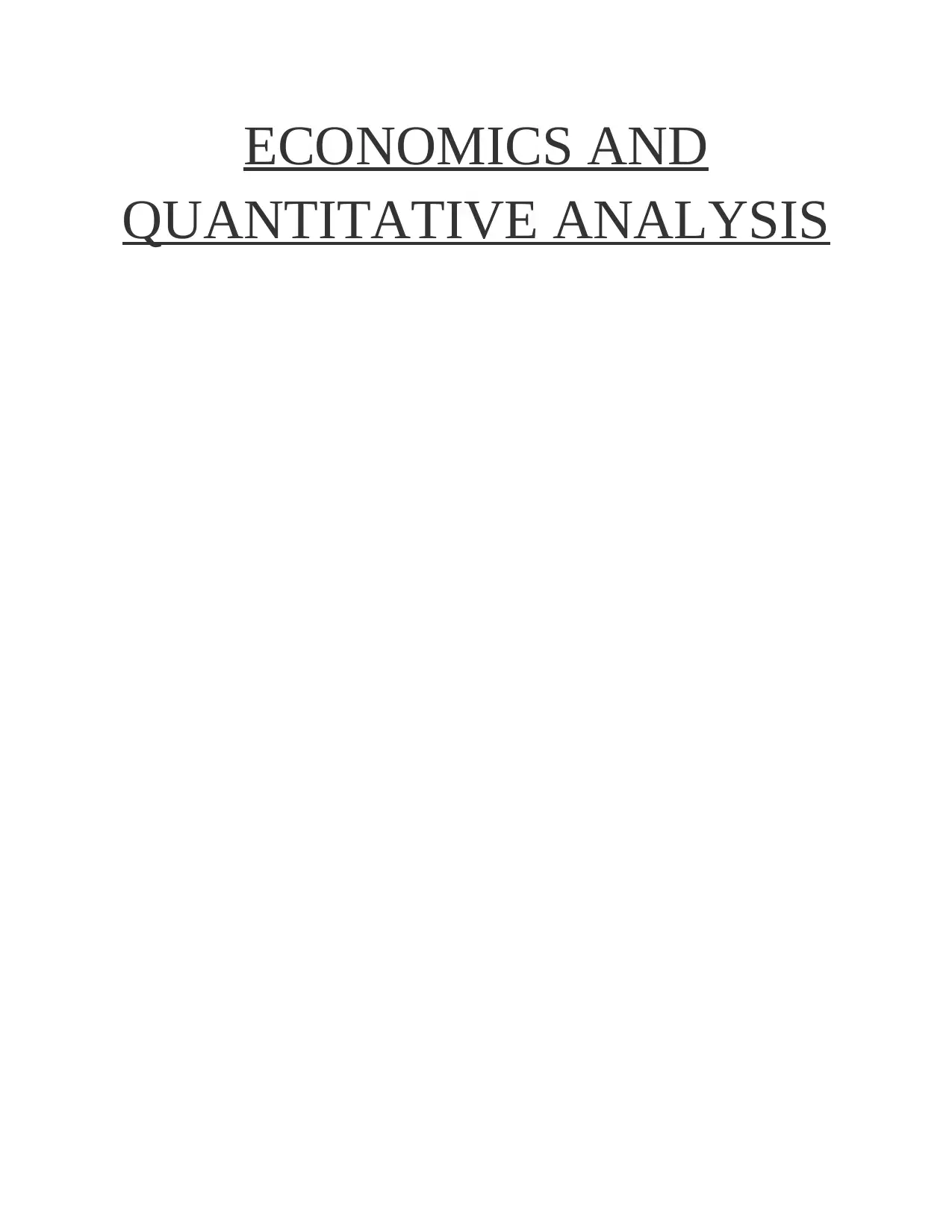
ECONOMICS AND
QUANTITATIVE ANALYSIS
QUANTITATIVE ANALYSIS
Paraphrase This Document
Need a fresh take? Get an instant paraphrase of this document with our AI Paraphraser
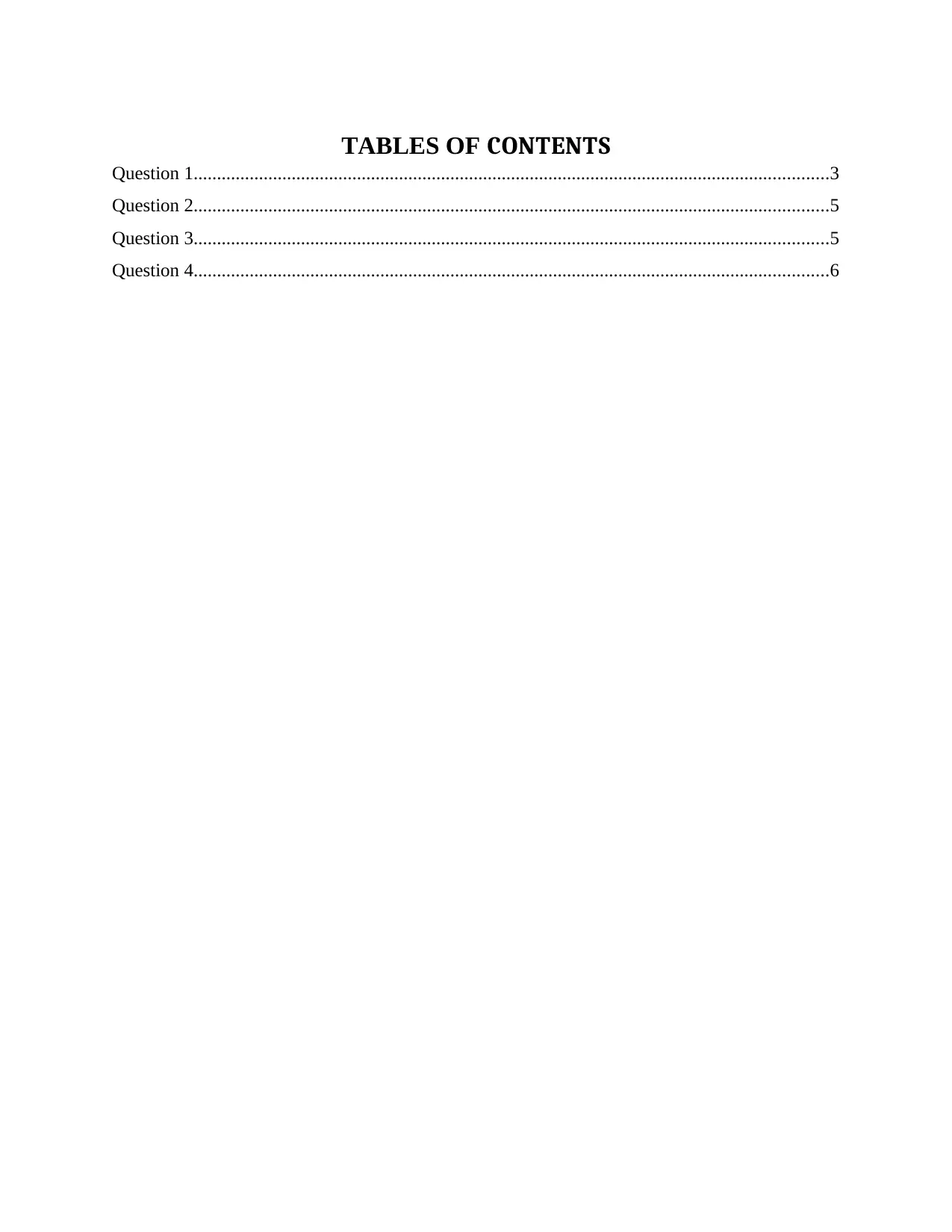
TABLES OF CONTENTS
Question 1........................................................................................................................................3
Question 2........................................................................................................................................5
Question 3........................................................................................................................................5
Question 4........................................................................................................................................6
Question 1........................................................................................................................................3
Question 2........................................................................................................................................5
Question 3........................................................................................................................................5
Question 4........................................................................................................................................6
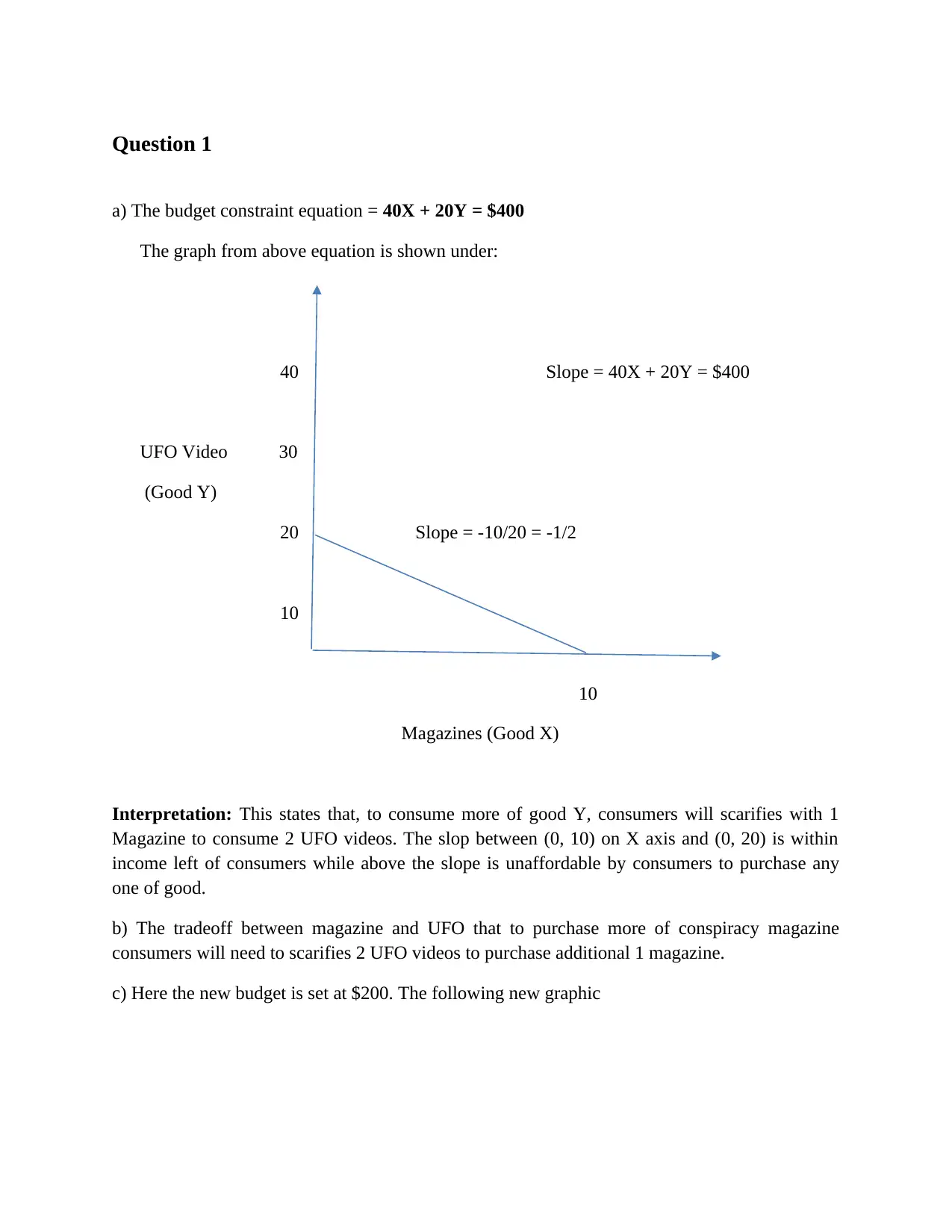
Question 1
a) The budget constraint equation = 40X + 20Y = $400
The graph from above equation is shown under:
40 Slope = 40X + 20Y = $400
UFO Video 30
(Good Y)
20 Slope = -10/20 = -1/2
10
10
Magazines (Good X)
Interpretation: This states that, to consume more of good Y, consumers will scarifies with 1
Magazine to consume 2 UFO videos. The slop between (0, 10) on X axis and (0, 20) is within
income left of consumers while above the slope is unaffordable by consumers to purchase any
one of good.
b) The tradeoff between magazine and UFO that to purchase more of conspiracy magazine
consumers will need to scarifies 2 UFO videos to purchase additional 1 magazine.
c) Here the new budget is set at $200. The following new graphic
a) The budget constraint equation = 40X + 20Y = $400
The graph from above equation is shown under:
40 Slope = 40X + 20Y = $400
UFO Video 30
(Good Y)
20 Slope = -10/20 = -1/2
10
10
Magazines (Good X)
Interpretation: This states that, to consume more of good Y, consumers will scarifies with 1
Magazine to consume 2 UFO videos. The slop between (0, 10) on X axis and (0, 20) is within
income left of consumers while above the slope is unaffordable by consumers to purchase any
one of good.
b) The tradeoff between magazine and UFO that to purchase more of conspiracy magazine
consumers will need to scarifies 2 UFO videos to purchase additional 1 magazine.
c) Here the new budget is set at $200. The following new graphic
You're viewing a preview
Unlock full access by subscribing today!
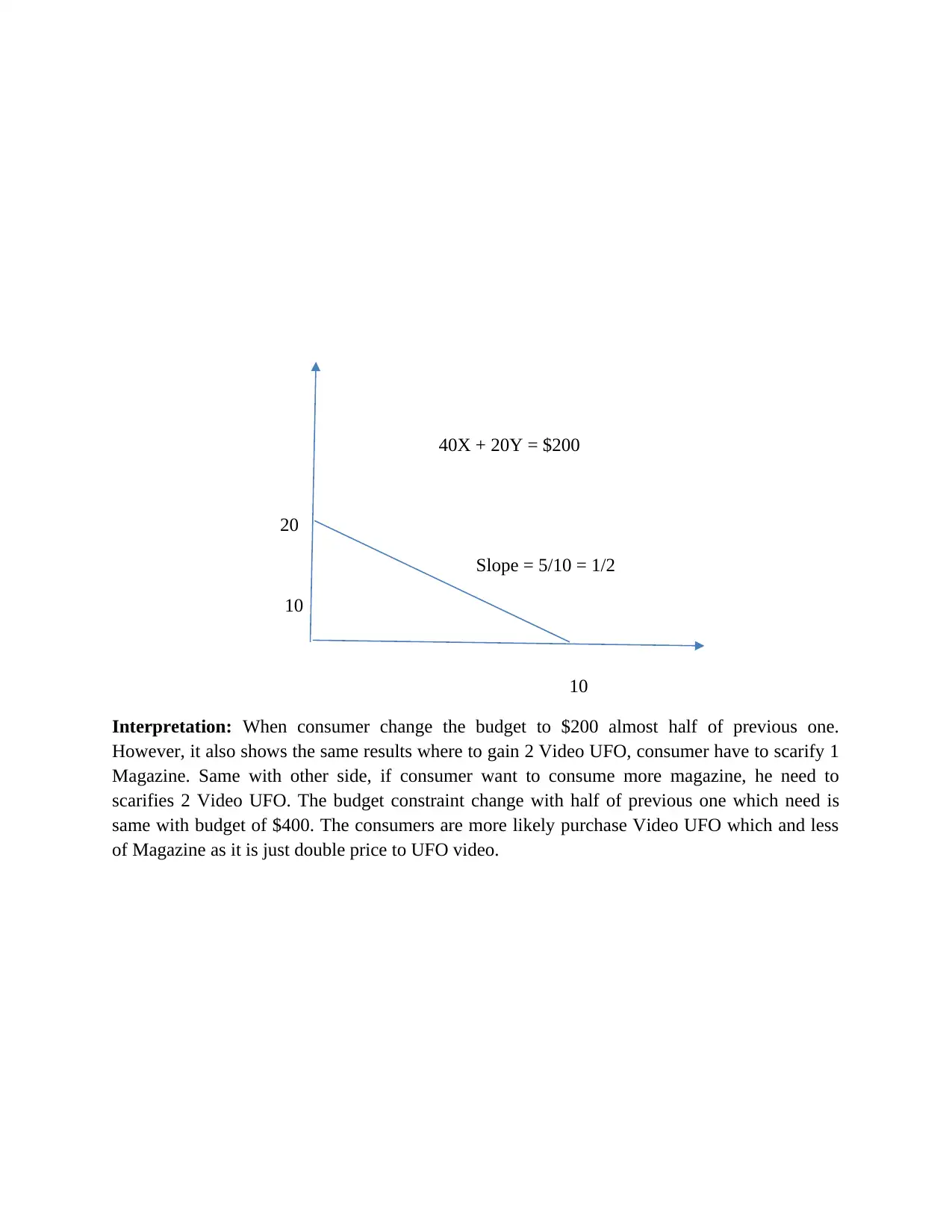
40X + 20Y = $200
20
Slope = 5/10 = 1/2
10
10
Interpretation: When consumer change the budget to $200 almost half of previous one.
However, it also shows the same results where to gain 2 Video UFO, consumer have to scarify 1
Magazine. Same with other side, if consumer want to consume more magazine, he need to
scarifies 2 Video UFO. The budget constraint change with half of previous one which need is
same with budget of $400. The consumers are more likely purchase Video UFO which and less
of Magazine as it is just double price to UFO video.
20
Slope = 5/10 = 1/2
10
10
Interpretation: When consumer change the budget to $200 almost half of previous one.
However, it also shows the same results where to gain 2 Video UFO, consumer have to scarify 1
Magazine. Same with other side, if consumer want to consume more magazine, he need to
scarifies 2 Video UFO. The budget constraint change with half of previous one which need is
same with budget of $400. The consumers are more likely purchase Video UFO which and less
of Magazine as it is just double price to UFO video.
Paraphrase This Document
Need a fresh take? Get an instant paraphrase of this document with our AI Paraphraser
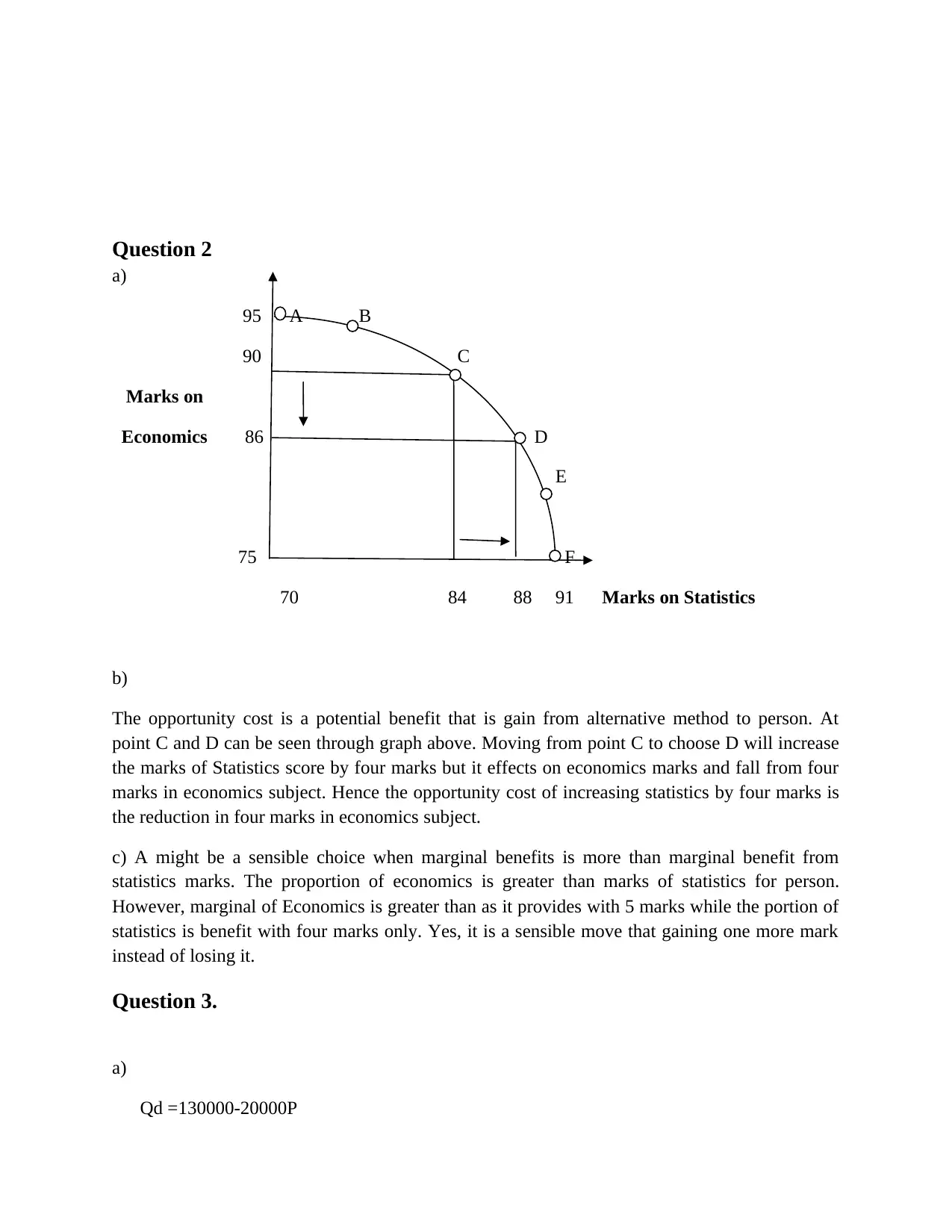
Question 2
a)
95 A B
90 C
Marks on
Economics 86 D
E
75 F
70 84 88 91 Marks on Statistics
b)
The opportunity cost is a potential benefit that is gain from alternative method to person. At
point C and D can be seen through graph above. Moving from point C to choose D will increase
the marks of Statistics score by four marks but it effects on economics marks and fall from four
marks in economics subject. Hence the opportunity cost of increasing statistics by four marks is
the reduction in four marks in economics subject.
c) A might be a sensible choice when marginal benefits is more than marginal benefit from
statistics marks. The proportion of economics is greater than marks of statistics for person.
However, marginal of Economics is greater than as it provides with 5 marks while the portion of
statistics is benefit with four marks only. Yes, it is a sensible move that gaining one more mark
instead of losing it.
Question 3.
a)
Qd =130000-20000P
a)
95 A B
90 C
Marks on
Economics 86 D
E
75 F
70 84 88 91 Marks on Statistics
b)
The opportunity cost is a potential benefit that is gain from alternative method to person. At
point C and D can be seen through graph above. Moving from point C to choose D will increase
the marks of Statistics score by four marks but it effects on economics marks and fall from four
marks in economics subject. Hence the opportunity cost of increasing statistics by four marks is
the reduction in four marks in economics subject.
c) A might be a sensible choice when marginal benefits is more than marginal benefit from
statistics marks. The proportion of economics is greater than marks of statistics for person.
However, marginal of Economics is greater than as it provides with 5 marks while the portion of
statistics is benefit with four marks only. Yes, it is a sensible move that gaining one more mark
instead of losing it.
Question 3.
a)
Qd =130000-20000P
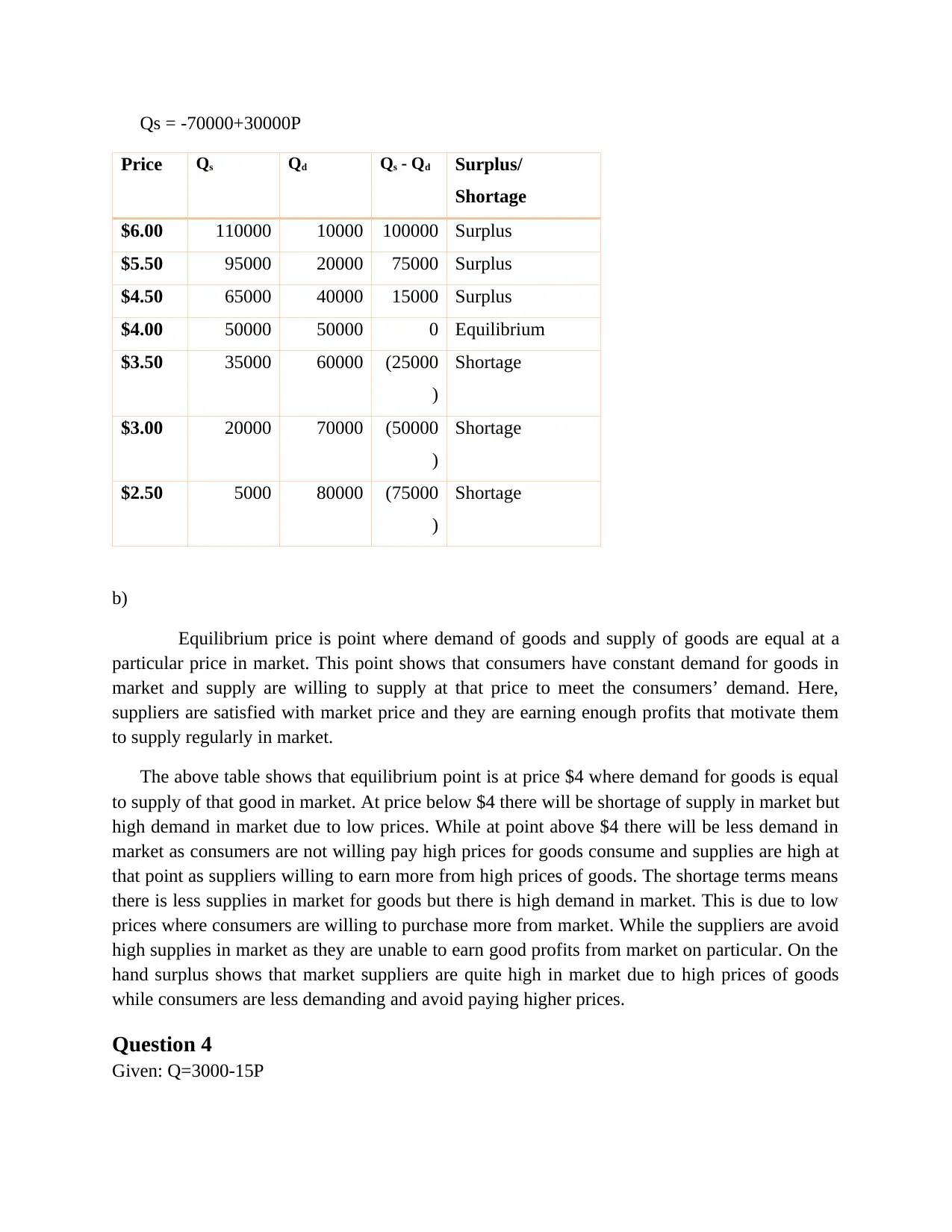
Qs = -70000+30000P
Price Qs Qd Qs - Qd Surplus/
Shortage
$6.00 110000 10000 100000 Surplus
$5.50 95000 20000 75000 Surplus
$4.50 65000 40000 15000 Surplus
$4.00 50000 50000 0 Equilibrium
$3.50 35000 60000 (25000
)
Shortage
$3.00 20000 70000 (50000
)
Shortage
$2.50 5000 80000 (75000
)
Shortage
b)
Equilibrium price is point where demand of goods and supply of goods are equal at a
particular price in market. This point shows that consumers have constant demand for goods in
market and supply are willing to supply at that price to meet the consumers’ demand. Here,
suppliers are satisfied with market price and they are earning enough profits that motivate them
to supply regularly in market.
The above table shows that equilibrium point is at price $4 where demand for goods is equal
to supply of that good in market. At price below $4 there will be shortage of supply in market but
high demand in market due to low prices. While at point above $4 there will be less demand in
market as consumers are not willing pay high prices for goods consume and supplies are high at
that point as suppliers willing to earn more from high prices of goods. The shortage terms means
there is less supplies in market for goods but there is high demand in market. This is due to low
prices where consumers are willing to purchase more from market. While the suppliers are avoid
high supplies in market as they are unable to earn good profits from market on particular. On the
hand surplus shows that market suppliers are quite high in market due to high prices of goods
while consumers are less demanding and avoid paying higher prices.
Question 4
Given: Q=3000-15P
Price Qs Qd Qs - Qd Surplus/
Shortage
$6.00 110000 10000 100000 Surplus
$5.50 95000 20000 75000 Surplus
$4.50 65000 40000 15000 Surplus
$4.00 50000 50000 0 Equilibrium
$3.50 35000 60000 (25000
)
Shortage
$3.00 20000 70000 (50000
)
Shortage
$2.50 5000 80000 (75000
)
Shortage
b)
Equilibrium price is point where demand of goods and supply of goods are equal at a
particular price in market. This point shows that consumers have constant demand for goods in
market and supply are willing to supply at that price to meet the consumers’ demand. Here,
suppliers are satisfied with market price and they are earning enough profits that motivate them
to supply regularly in market.
The above table shows that equilibrium point is at price $4 where demand for goods is equal
to supply of that good in market. At price below $4 there will be shortage of supply in market but
high demand in market due to low prices. While at point above $4 there will be less demand in
market as consumers are not willing pay high prices for goods consume and supplies are high at
that point as suppliers willing to earn more from high prices of goods. The shortage terms means
there is less supplies in market for goods but there is high demand in market. This is due to low
prices where consumers are willing to purchase more from market. While the suppliers are avoid
high supplies in market as they are unable to earn good profits from market on particular. On the
hand surplus shows that market suppliers are quite high in market due to high prices of goods
while consumers are less demanding and avoid paying higher prices.
Question 4
Given: Q=3000-15P
You're viewing a preview
Unlock full access by subscribing today!
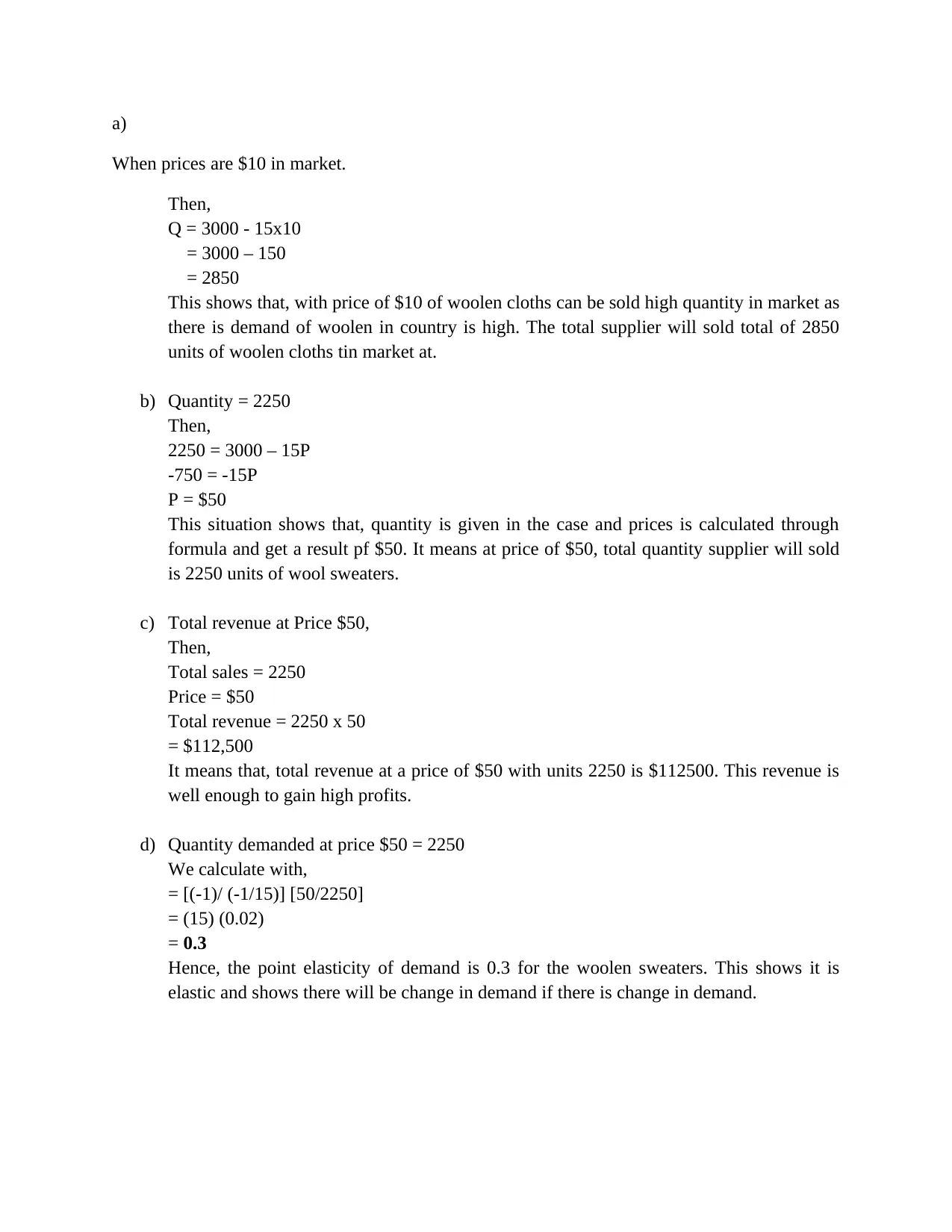
a)
When prices are $10 in market.
Then,
Q = 3000 - 15x10
= 3000 – 150
= 2850
This shows that, with price of $10 of woolen cloths can be sold high quantity in market as
there is demand of woolen in country is high. The total supplier will sold total of 2850
units of woolen cloths tin market at.
b) Quantity = 2250
Then,
2250 = 3000 – 15P
-750 = -15P
P = $50
This situation shows that, quantity is given in the case and prices is calculated through
formula and get a result pf $50. It means at price of $50, total quantity supplier will sold
is 2250 units of wool sweaters.
c) Total revenue at Price $50,
Then,
Total sales = 2250
Price = $50
Total revenue = 2250 x 50
= $112,500
It means that, total revenue at a price of $50 with units 2250 is $112500. This revenue is
well enough to gain high profits.
d) Quantity demanded at price $50 = 2250
We calculate with,
= [(-1)/ (-1/15)] [50/2250]
= (15) (0.02)
= 0.3
Hence, the point elasticity of demand is 0.3 for the woolen sweaters. This shows it is
elastic and shows there will be change in demand if there is change in demand.
When prices are $10 in market.
Then,
Q = 3000 - 15x10
= 3000 – 150
= 2850
This shows that, with price of $10 of woolen cloths can be sold high quantity in market as
there is demand of woolen in country is high. The total supplier will sold total of 2850
units of woolen cloths tin market at.
b) Quantity = 2250
Then,
2250 = 3000 – 15P
-750 = -15P
P = $50
This situation shows that, quantity is given in the case and prices is calculated through
formula and get a result pf $50. It means at price of $50, total quantity supplier will sold
is 2250 units of wool sweaters.
c) Total revenue at Price $50,
Then,
Total sales = 2250
Price = $50
Total revenue = 2250 x 50
= $112,500
It means that, total revenue at a price of $50 with units 2250 is $112500. This revenue is
well enough to gain high profits.
d) Quantity demanded at price $50 = 2250
We calculate with,
= [(-1)/ (-1/15)] [50/2250]
= (15) (0.02)
= 0.3
Hence, the point elasticity of demand is 0.3 for the woolen sweaters. This shows it is
elastic and shows there will be change in demand if there is change in demand.
Paraphrase This Document
Need a fresh take? Get an instant paraphrase of this document with our AI Paraphraser

1 out of 8
Your All-in-One AI-Powered Toolkit for Academic Success.
+13062052269
info@desklib.com
Available 24*7 on WhatsApp / Email
![[object Object]](/_next/static/media/star-bottom.7253800d.svg)
Unlock your academic potential
© 2024 | Zucol Services PVT LTD | All rights reserved.